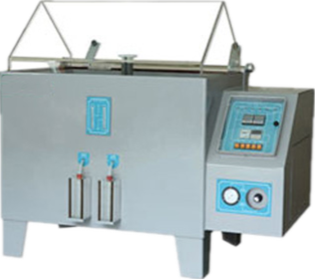
NewsInformation Center
What is salt spray testing and what equipment is required?
2023/09/22
Salt spray testing is a testing method used to evaluate the corrosion resistance of metals and coating materials in corrosive environments. It simulates the exposure of metal products to salt spray corrosion in marine climates or other saline environments to determine their corrosion resistance and the quality of protective coatings. The following is an introduction to salt spray testing:
1. Testing principle:
- Salt spray testing uses a mist of fine salt particles produced by a salt water solution to expose the sample surface to a high concentration of salt environment.
- The electrolyte environment and redox reactions generated by salt spray accelerate the corrosion process of metal, thus simulating the corrosion situation in the actual environment.
2. Equipment and laboratory requirements:
- Salt spray testing usually requires a specialized Standard Salt Spray Test Machine or salt spray test apparatus.
- The structure of the test chamber or room should be made of corrosion-resistant materials, such as PVC, PP, FRP, etc.
- The temperature, humidity and pressure in the room should be controlled within appropriate ranges to ensure the accuracy of the test.
- Equipment should usually be equipped with a circulation system and filtration system to control the supply and discharge of brine and maintain the stability of the test environment.
3. Sample preparation:
- Select appropriate samples for testing based on the purpose and requirements of the test.
- If coating materials are involved, they need to be properly pre-treated in accordance with relevant standards, such as surface cleaning, grinding, degreasing, etc.
- Before testing, it is necessary to ensure that the sample reaches a stable state and undergoes necessary pre-treatment, such as drying, heating or other conditions.
4. Test parameter settings:
- Determine the duration of the test, usually in hours or days.
- Set the concentration of the saline solution and the spray method, such as atomizer or nozzle.
- Control the temperature and humidity in the salt spray chamber to ensure compliance with test standards.
5. Execute the test:
- Place the samples in a suitable location, ensuring distance between samples to avoid mutual interference.
- Turn on the salt spray generation device to create a salt spray environment.
- Monitor and record temperature, humidity and salt spray concentration in the test chamber during testing.
- Regularly observe and record the corrosion status and changes of samples.
6. Evaluation of test results:
- Assess the corrosion degree of the sample, such as corrosion area, color change, oxidation degree, etc., in accordance with testing standards or requirements.
- Carry out appropriate surface inspections, measurements and analyzes to determine corrosion conditions and performance losses.
- Compare the corrosion differences of different samples or different coatings to evaluate their corrosion resistance and the quality of the protective coating.
Salt spray test is a commonly used corrosion resistance evaluation method and is widely used in metal products, coating materials, electronic components, automotive parts and other fields. It can help manufacturers improve product design, material selection and protective measures to improve product corrosion resistance and lifespan. At the same time, salt spray test results can also be used in product certification, quality control and supply chain management.
Previous: What is the accelerated aging test process?
N e x t : What are the key parameters measured during an oxygen index test?




